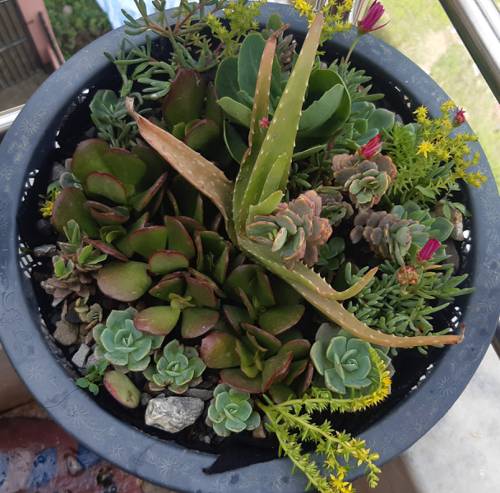
FAQ About Indoor Plant Ecosystem Mimicry

What is indoor plant ecosystem mimicry?
Indoor plant ecosystem mimicry involves recreating the natural conditions and interactions found in outdoor ecosystems within an indoor environment. This approach seeks to create a balanced and sustainable habitat for plants by simulating factors like soil composition, humidity, temperature, and light levels. By mirroring these natural ecosystems, plant health and biodiversity can be enhanced, promoting a thriving indoor garden.

Why is mimicking a natural ecosystem indoors beneficial for plants?
Mimicking natural ecosystems indoors helps ensure that plants receive the conditions they are naturally adapted to thrive in. This approach can lead to healthier plants, reduced stress, and improved growth and productivity. By creating a balanced environment, ecosystem mimicry can also enhance biodiversity, reduce pest outbreaks, and minimize the need for chemical fertilizers and pesticides.

How can I create a balanced indoor plant ecosystem?
To create a balanced indoor plant ecosystem, consider factors such as light, humidity, temperature, soil quality, and plant diversity. Start by selecting plants with similar environmental needs to improve compatibility. Use soil mixes that promote healthy root growth and support beneficial microorganisms. Maintain optimal humidity and temperature levels, and ensure that each plant receives appropriate levels of light. Incorporating elements like water features or grow lights can help achieve these conditions.

What plants are suitable for creating an indoor ecosystem mimicry?
Suitable plants for an indoor ecosystem mimicry include species that are known to thrive in indoor conditions and have similar environmental needs. Consider using plants like ferns, spider plants, pothos, peace lilies, and philodendrons. These species are adaptable to varying light conditions and can coexist well, providing support to one another, much like in natural ecosystems.

Can ecosystem mimicry help with pest control indoors?
Yes, ecosystem mimicry can help with pest control. By cultivating a diverse range of plants and creating a balanced environment, you attract beneficial insects and microorganisms that naturally control pest populations. A healthy ecosystem can resist pest outbreaks and reduce reliance on chemical pesticides, making it a more sustainable approach to indoor gardening.

How does soil composition impact indoor plant ecosystems?
Soil composition is crucial in indoor plant ecosystems as it affects water retention, nutrient availability, and root health. A balanced soil mix containing organic matter, minerals, and microorganisms helps support plant growth and mimic natural soil conditions. Well-aerated soil ensures proper drainage and reduces the risk of root diseases, promoting a healthy plant ecosystem.

What role does humidity play in indoor plant ecosystems?
Humidity plays a significant role in indoor plant ecosystems as it affects transpiration, nutrient uptake, and overall plant health. Adequate humidity levels prevent plants from drying out and maintain leaf health. Many tropical plants, commonly found in indoor settings, thrive with higher humidity levels. Using humidifiers or placing plants in naturally humid areas, such as bathrooms, can help maintain the required moisture levels.

Is artificial lighting necessary for mimicking ecosystems indoors?
Artificial lighting can be necessary for mimicking ecosystems indoors, especially in areas with insufficient natural light. Grow lights that simulate sunlight can provide the spectrum and intensity required for photosynthesis, supporting plant growth. Consider using LED or fluorescent grow lights, which are energy-efficient and tailored to different plant light needs.

How does plant diversity affect an indoor ecosystem?
Plant diversity within an indoor ecosystem creates a more resilient and balanced environment. Adding a variety of species can increase biodiversity, encourage beneficial interactions, and reduce the likelihood of pest infestations. Diverse plant groups can also fill different ecological niches, utilizing available resources more efficiently and stabilizing the ecosystem over time.

What are some common mistakes in attempting indoor ecosystem mimicry?
Common mistakes include selecting incompatible plant species, neglecting environmental conditions like humidity and temperature, and overwatering or underwatering plants. It's also essential to provide sufficient light and choose the appropriate soil type. A lack of understanding of each plant's requirements can lead to an imbalanced ecosystem and poor plant health.

How can I introduce beneficial insects into an indoor plant ecosystem?
Introducing beneficial insects to an indoor plant ecosystem can be done by purchasing them from reputable suppliers. Species like ladybugs, predatory mites, and parasitoid wasps are effective in controlling common pests naturally. Ensure that your indoor environment can support these insects, and monitor the balance between pest and beneficial insect populations.

What is the role of microorganisms in an indoor plant ecosystem?
Microorganisms play a vital role in indoor plant ecosystems by facilitating nutrient cycling, improving soil structure, and enhancing plant health. Bacteria, fungi, and mycorrhizae help decompose organic matter, making nutrients available to plants. They also contribute to disease resistance and improve root growth by forming symbiotic relationships with plants.

How does temperature affect an indoor plant ecosystem?
Temperature affects metabolism, growth rates, and overall plant health in an indoor plant ecosystem. Plants have specific temperature ranges they thrive in, and maintaining consistent conditions is crucial. Sudden changes in temperature can cause stress, reduce growth, and increase susceptibility to diseases and pests. Utilizing temperature controls like thermostats or heat mats can help maintain optimal conditions.

What technology can help in creating an indoor plant ecosystem?
Several technologies can assist in creating an indoor plant ecosystem, such as smart climate control systems, automated watering systems, and grow lights. Smart devices can monitor humidity, temperature, and light levels, adjusting them as needed. Soil sensors can provide insights into moisture levels, ensuring accurate watering schedules. These technologies help maintain consistent conditions for plant health.

Can indoor ecosystems support edible plants?
Yes, indoor ecosystems can support edible plants such as herbs, vegetables, and small fruits. By selecting appropriate containers, soil, and lighting, you can create an environment suitable for growing food indoors. Herbs like basil, mint, and parsley, and vegetables such as lettuce and radishes, are well-suited for indoor cultivation and can thrive in a well-maintained indoor ecosystem.

How can I measure the success of my indoor plant ecosystem?
The success of an indoor plant ecosystem can be measured by observing plant health, growth rate, and biodiversity. Assess whether plants exhibit vibrant colors, new shoots, and increased yields over time. A balanced ecosystem will also have minimal pest and disease problems. Regular monitoring and adjustments to your ecosystem can help maintain its success.

What are the cost implications of establishing an indoor plant ecosystem?
The cost implications can vary widely depending on the complexity and scale of the indoor plant ecosystem. Initial investments may include purchasing plants, soil, containers, lighting, and climate control systems. However, these systems can lead to long-term savings by reducing the need for pest control and chemical fertilizers. Researching and planning your ecosystem can help manage costs effectively.

How does ecosystem mimicry indoors contribute to sustainability?
Ecosystem mimicry indoors contributes to sustainability by promoting biodiversity, reducing the need for fertilizers and pesticides, and utilizing natural pest control methods. This approach minimizes environmental impact and resource use, creating a self-sustaining system that requires less intervention. By fostering a balanced ecosystem, you can support plant health naturally and responsibly.

What are the steps to start an indoor ecosystem mimicry project?
To start an indoor ecosystem mimicry project, begin by researching the environmental needs of plants you wish to include. Set up your space with appropriate lighting, humidity, and temperature controls. Use high-quality soil and select compatible plant species. Implement eco-friendly practices, such as composting and natural pest control, to maintain a sustainable system. Regularly monitor and adjust your setup as plants grow and change.

Are there any risks associated with indoor ecosystem mimicry?
While creating an indoor ecosystem mimicry generally promotes plant health, there are some risks such as imbalanced conditions leading to pest infestations or disease outbreaks. Over-reliance on technology without understanding basic plant needs can also pose a risk. Proper research, monitoring, and maintenance can mitigate these risks by ensuring that conditions remain balanced and conducive to plant health.
